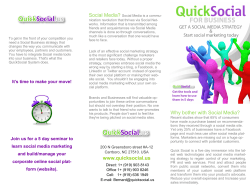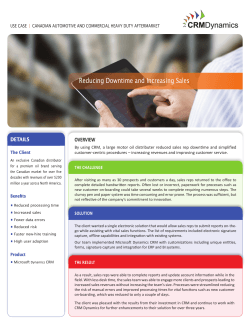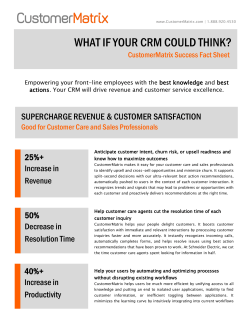
List and explain the three CRM technology components.
[ Winter 2014 PROGRAM SEMESTER SUBJECT CODE & NAME CREDIT BK ID MAX. MARKS Q.No ] ASSIGNMENT – SCHEME OF EVALUATION Master of Science in Information Technology(MSc IT)Revised Fall 2011 4 MIT4024– Customer Relationship Management 4 B1635 60 Question and Scheme of Evaluation 1 List and explain the three CRM technology components. A There are three CRM technology components. They are” Unit/ Page No. 10 7 [10] List any ten features of SFA. The main features of SFA are (list any ten): (i) Lead management (ii) Opportunity management (iii) Global forecasting (iv) Territory management (v) Customizable forecasting (vi) Approvals and workflow (vii) Account and contact management (viii)Activity management (ix) Product catalog (x) Document management (xi) Contract management (xii) Email templates (xiii)Asset management (xiv) Partner management (xv) Reports and dashboards (xvi) Data quality management (xvii) Mobile solutions [10] 3 Explanation A Total Marks 2/29 (i) CRM engine (ii) Front office solutions (iii) Enterprise Application Integrations (EAI) 2 Marks 3/51 10 Page 1 of 3 10 3 Define Decision Support System (DSS). List the features of DSS. A Decision Support System (DSS) is defined as a computer-based information system that aids the business organizations with their decisionmaking process. [10] 5/101 Features of DSS: 4 List out the business benefits of Response tracking. A Business benefits of Response tracking are: (i) Response tracking using mobile allows the marketers to track message delivery rate, response rate and sales conversion rate for a campaign thus, resulting in better ROI. (ii) Response tracking using e-mails allows marketers to track responses of the customers. It tracks mails opened, mails replied to, mails bounced etc. Thus, it allows marketers to augment Know Your Customer (KYC) metrics. (iii) Response tracking through e-mail results in locating the interested customers. It further allows marketers to approach those customers via different touch points, leading to strong customer relationship and enriched data in CRM. (iv) Response tracking via e-mail also helps in strengthening the customer relationship through personalized communication, which helps the customer feel that organizations set high KYC standards. (v) Response tracking on Web through personalized landing pages and personalized offers based on strategic customer segmentation allows organizations to understand customer behavior and their inclination towards the offer. (vi) Once the customer makes an inbound call, he is asked to validate the call. This is also a technique to track the effectiveness of the response. 10 3 7 [10] 6/120 10 10 (vii) Response tracking allows organizations to improve the response rates greatly by means of customization and tailoring of messages. (viii)By using multi-level response tracking organizations can realize multitiered marketing initiatives. (ix) 5 A Response tracking also helps organizations to reap the benefits of viral marketing, resulting in customer retention and customer acquisition. What are the basic steps in project planning? The following steps are followed in project planning: [10] 9/184 10 Page 2 of 3 10 1. Breaking up of the requirement specifications into smaller subtasks or activities 2. Sequencing of activities and identifying activities that can be implemented at the same time 3. Framing a resource plan that shows and quantifies the required labour, equipment and materials for each activity 4. Identifying the time schedule for each activity and parallel running activities 5. Working out the financial plan which describes the total quantity of financial resources required during each stage of the project 6. Framing the quality plan that ensures that the project deliverables meet requirements accurately 7. Formulating the risk plan that identifies all foreseeable risks and rates them in terms of likelihood of occurrence and their potential impact on the project 8. Prioritizing the risks and identifying a set of actions to reduce the likelihood and impact of each risk on the project 9. Formulating the acceptance plan that ensures that the outputs meet the requirements stated in the quality plan. 6 A [10] Explain about the RFM Model. The RFM (Recency Frequency Monetary value) model is used for evaluation of customers. After analysis of customer data over time it is found that customers who bought products recently are likely to buy again compared to the customers who have not purchased anything for a long time. 14/298,29 9 2 8 Further Explanation: *A-Answer *********** Page 3 of 3 10
© Copyright 2025





















